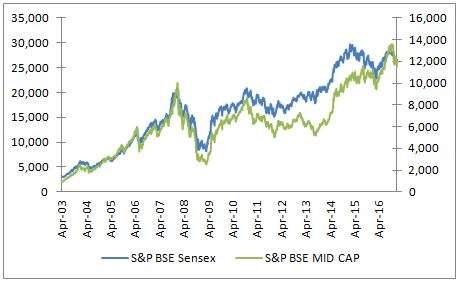We’ve looked at what large-cap funds are, and why they are a must-have in your long-term portfolio. This week, we will take up the midcap fund category.
What midcap funds are
The entire stock universe is grouped according to market capitalisation. A stock’s market cap is the product of its share price and the total number of shares it has. By market cap, a stock can be large, mid, or small. Midcap funds are those that invest in mostly mid-cap stocks.
Why midcaps
A midcap stock usually represents smaller companies. Such companies have the potential to post high growth rates as they expand, with several opportunities at their disposal. Large companies, because they are already established, will find it hard to improve significantly on their expansion growth rates. Large companies reach a steady state of growth, while the smaller ones (and thus mid-cap and small-cap stocks) are still in the rapid growth phase.  This potential echoes in the stock price. Mid-cap and small-cap stocks can deliver bigger gains as the underlying companies generate strong growth in revenues and earnings. Large-cap stocks will deliver gains to a comparatively smaller extent because of the comparatively lower growth rate.
This potential echoes in the stock price. Mid-cap and small-cap stocks can deliver bigger gains as the underlying companies generate strong growth in revenues and earnings. Large-cap stocks will deliver gains to a comparatively smaller extent because of the comparatively lower growth rate.
The risk in midcaps
But outsized gains are when the markets, the industry, and the economy are going good. When times turn for the worse, a smaller or mid-sized company will find it much harder than a large company. A small company lacks the size to absorb lower returns or losses due to poor market conditions for very long. With a dependence on expansion, any hiccup or delay in expansion may choke revenues and earnings growth.
Such companies may be unable to command pricing power over its customers. It will get harder to raise funds for operations and expansion, or it will have to do so at higher costs, which in turn eats into profitability. This sends prices crashing. Midcap and smallcap stocks tend to have steeper falls than large-cap stocks even as they can post bigger gains. The steeper the fall, the harder it is to recover.
 For example, after the 2008 crash, the largecap bellwether BSE Sensex crossed the 2008 high by end of 2013. At the time, the midcap and small-cap indices were still at half their 2008 highs. In fact, the BSE Midcap index managed to cross its 2008 only around June 2016. It has taken the three successive years of positivity in the mid-and-small-cap segment to accomplish this. The graph shows how the Sensex and the BSE Midcap index have performed since 2004. Look at how the midcaps have taken time to catch up to the largecaps. This is why, though mid-caps have the capacity to deliver outsized gains, you do not put all your money in this category.
For example, after the 2008 crash, the largecap bellwether BSE Sensex crossed the 2008 high by end of 2013. At the time, the midcap and small-cap indices were still at half their 2008 highs. In fact, the BSE Midcap index managed to cross its 2008 only around June 2016. It has taken the three successive years of positivity in the mid-and-small-cap segment to accomplish this. The graph shows how the Sensex and the BSE Midcap index have performed since 2004. Look at how the midcaps have taken time to catch up to the largecaps. This is why, though mid-caps have the capacity to deliver outsized gains, you do not put all your money in this category.
Defining midcaps
Midcap funds have different ways in which they define stocks as being midcaps. Some classify any stock that is outside the top 100 by market capitalisation as being a midcap. Some peg the market cap range of the BSE Midcap index or the Nifty Freefloat Midcap 100 index to define the midcap stock universe. Some have fixed market cap definitions. At FundsIndia, we define a midcap stock as one with a market cap between Rs 3,000 crore and Rs 20,000 crore. As prices and market caps change, we review this range on a quarterly basis.
There are about 1700 traded stocks on the two exchanges together. So imagine the enormous number of stocks that can be considered a midcap, whatever the definition may be. Funds, thus, have a wide variance in their portfolios and therefore in their risk.
Funds that focus on the higher end of the market cap range –around Rs 10,000 crore to Rs 20,000 crore – are less risky, because they find companies that are reasonably established, are on their way to being large-caps, and are more stable. Funds that focus towards the lower end of the range – about Rs 4,000 crore to Rs 10,000 crore – are riskier because such companies are only just emerging and can quickly take a turn for the worse in adverse conditions. Funds also allocate portions of their portfolios to even smaller stocks, which heightens their risk profile. So when you choose midcap funds, understand its risk.
Portfolio role
Midcap funds help lift your portfolio’s returns – they give a boost to your portfolio to generate better long-term returns. These funds need to be held for five years at least to deliver. If you are cannot stomach volatility or steep short-term losses in your portfolio, then its best to stay away from midcap funds. If you can take the risk, mid-cap funds are a useful addition. It may not be prudent to allocate more than a third of your portfolio to midcap funds, no matter your time horizon, age, or risk appetite.








Thanks for this information. Investing in Midcap funds or Mutual funds is the best way to secure future and money as well.
Thanks for this information. Investing in Midcap funds or Mutual funds is the best way to secure future and money as well.
I want to invest Rs. 3000 for long term in mid cap fund. Just suggest me one. I have shortlisted Franklin India Prima, L&T Midcap, L&T India Value. Are any one of them is good to keep? If otherwise then suggest me one good fund for midcap.
Regards,
Debasis
Hello,
Franklin India Prima and L&T India Value are both quality mid-cap funds, suitable for the long-term. However, you need to ensure that your entire investment is not restricted to mid-cap funds alone, since they are highly risky. Please keep in mind your risk level before investing.
Thanks,
Bhavana
Thanks Bhavna,
My portfolio includes Birla sunlife frontline, HDFC top 200, ICICI Pru focussed bluechip, ICICI Pru value discovery and SBI bluechip, Rs. 3000 each. Along with them I want to include Franklin India Prima. Is this OK? Or do I need any further diversification? Plz advise.
Regards,
Debasis
Your funds are good for the long term. Please note that HDFC Top 200 is a volatile fund and can suffer from long periods of lower returns. For a detailed portfolio review including asset allocation and fund suitability, please use your FundsIndia account to schedule an appointment with your advisor. We are restrained from providing portfolio specific advice on this forum.
Thanks,
Bhavana
I want to invest in mid cap fund for long run. Shortlisted Franklin India Prima, L&T Midcap, L&T India Value fund. Are any one of them good enough? Otherwise suggest me.
Regards,
I want to invest Rs. 3000 for long term in mid cap fund. Just suggest me one. I have shortlisted Franklin India Prima, L&T Midcap, L&T India Value. Are any one of them is good to keep? If otherwise then suggest me one good fund for midcap.
Regards,
Debasis
Hello,
Franklin India Prima and L&T India Value are both quality mid-cap funds, suitable for the long-term. However, you need to ensure that your entire investment is not restricted to mid-cap funds alone, since they are highly risky. Please keep in mind your risk level before investing.
Thanks,
Bhavana
Thanks Bhavna,
My portfolio includes Birla sunlife frontline, HDFC top 200, ICICI Pru focussed bluechip, ICICI Pru value discovery and SBI bluechip, Rs. 3000 each. Along with them I want to include Franklin India Prima. Is this OK? Or do I need any further diversification? Plz advise.
Regards,
Debasis
Your funds are good for the long term. Please note that HDFC Top 200 is a volatile fund and can suffer from long periods of lower returns. For a detailed portfolio review including asset allocation and fund suitability, please use your FundsIndia account to schedule an appointment with your advisor. We are restrained from providing portfolio specific advice on this forum.
Thanks,
Bhavana
I want to invest in mid cap fund for long run. Shortlisted Franklin India Prima, L&T Midcap, L&T India Value fund. Are any one of them good enough? Otherwise suggest me.
Regards,